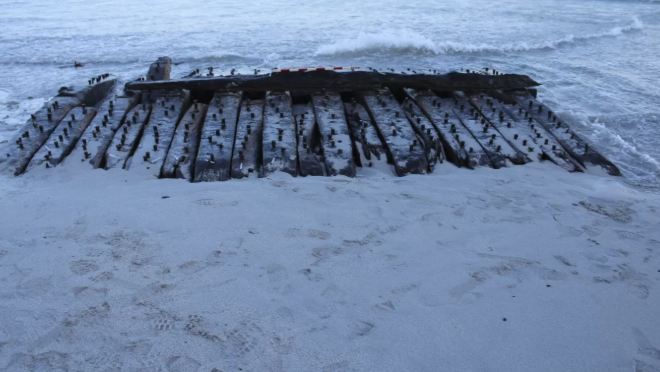Science and local sleuthing uncover 250-year-old Shipwreck on Scottish Island
Science and local sleuthing uncover 250-year-old Shipwreck on Scottish Island

A routine run by a schoolboy led to a remarkable discovery on a remote Scottish beach, where the exposed wooden ribs of a buried ship sparked an investigation by archaeologists, scientists, and local historians. Their collaborative efforts have now identified the wreck as likely being the Earl of Chatham — a vessel with a rich history spanning war and whaling.
Researchers revealed on Wednesday that the ship was once a British Royal Navy frigate named HMS Hind, built in 1749, which served in the American War of Independence before being repurposed as a whaling ship in the Arctic. It eventually met its fate in a storm off the coast of Sanday, one of the Orkney Islands.
Ben Saunders, senior marine archaeologist at Wessex Archaeology, described the discovery as the result of both scientific precision and community spirit.
“I’d call it a lucky ship — even though it sank,” said Saunders. “In many other locations, such a find might not have received the same local interest or commitment to investigate and preserve it.”
Revealed after centuries
The wreck resurfaced in February 2024 when a storm stripped away layers of sand on Sanday Island, revealing parts of the wooden hull. Home to just 500 residents and a long maritime history, the island has recorded around 270 shipwrecks over the centuries.
Local farmers helped transport 12 tons of oak timbers from the beach using tractors, while community volunteers took on the task of researching the ship’s origins.
“It was a great experience — everyone came together,” said community researcher Sylvia Thorne. “Now, many are becoming deeply engaged and quite knowledgeable about it.”
Using dendrochronology — the method of dating wood through tree rings — scientists determined the timber originated from southern England in the mid-1700s. This coincided with a period when Britain began keeping detailed maritime records, offering valuable leads.By eliminating non-British ships and others inconsistent with the location or size, researchers were left with just a few possible identities. The Earl of Chatham emerged as the most plausible.
A ship of war and whales
Initially commissioned as the HMS Hind, the ship participated in major battles during the Seven Years’ War, including the sieges of Louisbourg and Quebec. In the 1770s, it escorted convoys during Britain’s efforts to retain control over the American colonies.
Decommissioned and sold in 1784, it was renamed the Earl of Chatham and used in the booming Arctic whaling industry. By 1787, the vessel was one of 120 London-based whaling ships operating in the Greenland Sea. But in 1788, it was wrecked during a storm off Sanday. Remarkably, all 56 crew members survived — reinforcing its reputation for good fortune, said Saunders.
Preservation and pride
The remains of the ship are now being preserved in a freshwater tank at the Sanday Heritage Centre, with plans for a permanent exhibition underway.
Saunders praised the strong local involvement: “This discovery, recovery, and preservation are all thanks to the people of Sanday. Their enthusiasm and sense of ownership made it possible.”
Locals see the wreck not just as a historical artifact, but as a living connection to their seafaring roots — and a sign of more discoveries to come as climate change reshapes coastal landscapes.
“One of the most powerful takeaways from this project,” said community researcher Ruth Peace, “is realizing how much of Sanday’s past remains all around us — sometimes visible, sometimes just beneath the surface.”


